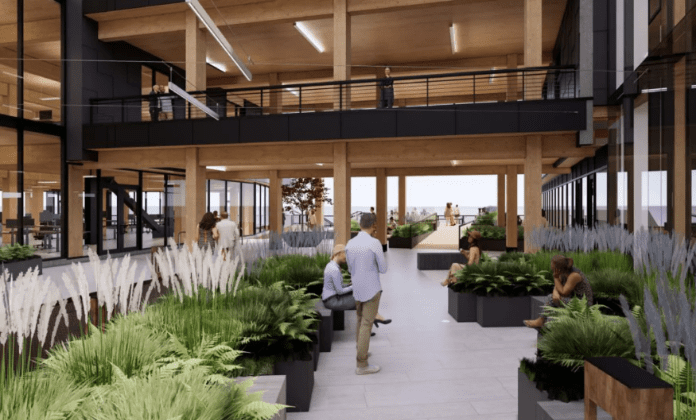
Seattle mass timber advocates see opportunity for growth
The climb up several flights of metal scaffolding stairs to the top level of a construction site on the northern edge of Lake Union in Seattle reveals a panoramic view.
From this open-air bridge that connects the two sides of the Northlake Commons building, my tour guide Thomas Stearns and I look across the water to see the Seattle skyline and Space Needle.
“You look over here, you can see the Montlake cut and UW,” said Stearns. “And especially when the rowing team is out and they’re coming through the cut and out to Lake Union, it’s pretty special.”
Stearns is operations manager for Swinerton, the general contractor on this four-story mass timber mixed-use building that will feature office, lab, and retail space. It’s one example of a mass timber building that’s actually rising from the ground as developers in cities, including Seattle, look for ways to reduce carbon emissions, but keep building to accommodate a growing population.
While mass timber has taken off in parts of Europe and just to our north in British Columbia, the movement has been slower to take root in the U.S.
‘It’s a little bit more inviting’
The timber for Northlake Commons was sourced from British Columbia and fabricated at Timberlab in Portland.
Planks of Douglas fir and spruce are glued together for the beams and columns (known as Glulam or Glued Laminated Timber). These combined with Cross Laminated Timber, or CLT, pine panels give the building a distinct look.
“It just gives you a little bit different reaction and feeling to the space you’re in. Feels a lot warmer; it’s a little bit more inviting,” Stearns said.
But this return to wood is about more than just aesthetics.
Figures vary and research is ongoing, but a 2019 study led by researchers from the University of Washington found a more than 26% reduction in global warming potential building with CLT as opposed to more energy-intensive concrete and steel construction.
And because much of the work is done off-site, mass timber advocates also point to a faster construction project with smaller crews on site.
While these benefits of mass timber have been talked about for years, several projects in the Northwest haven’t panned out. But some mass timber buildings like Northlake Commons are going vertical
“We really hope we can have a signature spot that people can enjoy,” said Joanna Callahan, whose company HCG Group, is the developer behind Northlake Commons.
“We actually had been wanting to do mass timber for quite some time and we looked at it in 2015 for another project that ultimately ended up being steel,” said Callahan. “And the issue was we couldn’t find a CLT supplier in the U.S. We would have actually had to ship it from Europe.”
But flash forward to 2023, more suppliers, (like Kalesnikoff, Mercer International, Vaagen Timber and Freres Engineered Wood in Lyons, Oregon) means a more cost-effective way to build mass timber buildings.
“We had multiple suppliers and multiple options and we felt like we would be able to do it,” said Callahan.
UW Tacoma recently opened Milgard Hall, a mass timber building on its campus.
The last few years have also brought changes to building codes, potentially opening the door for more mass timber structures in the Northwest and throughout the U.S.
“We’re gonna see a lot more taller buildings, up in the 16-story range. So I think there’s a good opportunity in the multi-family market,” said Cody Lodi with Weber Thompson, the architect behind Northlake Commons.”
‘One key strategy’
Unlike office space following the pandemic, there’s no shortage of demand for residential buildings.
“We’re in desperate need of housing for people in our country and in our city,” said Susan Jones, whose architecture firm, Atelier Jones, designed a residential mass timber building going up in Seattle’s Capitol Hill neighborhood called Heartwood.
Jones has spent the last decade championing mass timber construction. She helped research the new building codes; she’s even written a book on the subject.
“It’s certainly not going to solve climate change, but it is one key strategy to help potentially lower our architecture, engineering and construction’s incredibly damning carbon footprint on this globe,” said Jones.
She believes the Pacific Northwest and its longstanding relationship with the timber industry is uniquely suited to be a leader in mass timber construction in the U.S. Although she understands that, for some, cutting down more trees may seem counterintuitive to sustainability.
“In most cases, the forests that we’re working with are definitely not the not the ‘old growth forests’ that we all love and revere and never want to touch, but they’re managed forests,” said Jones. “That means that they’re second or third growth level in generation forests, and those second and third generation forests really do need a different level of management.”
Jones says while mass timber construction in the U.S. is behind other countries, she believes the urgency to change the way we build will spur more growth.
“We have this intractable problem of climate change, having to lower our carbon footprint drastically immediately as fast as we possibly can,” said Jones.
And soon, Seattle will have at least two new examples of mass timber buildings to show off to the world.


